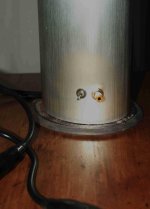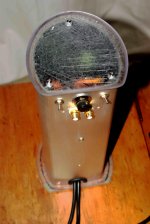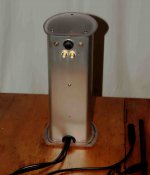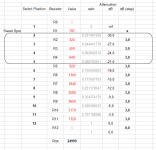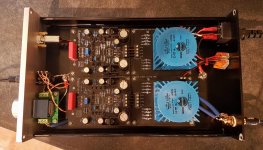build the Sapphire in a 150 mm dia. pipe
Yes...that is my build too. 🙂
Using a d-section aluminium tube...and umbilicals. Only vertical.
Functional but still to finish appearance.
Front has H/P out and mute switch.
Back has inputs and toggle switches for direct or pot... balance can be made too by switching 1 ch to pot and adjusting.
Boards are mounted nose to nose on a slide-out plate as the 'tube' has a pc-board slot.
Attachments
Hi guys, I wanted to get rid of the potentiomer, obviously inside my sapphire, and put a 12 step 71BD30-02-1-AJN from Grayhill builded by me. What do you think about it?
What kind of resistor should I use in your opinion, and why?
I will appreciate any kind of opinion and tip.
Technically it should be 25k but I will put the first pin to gnd and the last pin to input.
What kind of resistor should I use in your opinion, and why?
I will appreciate any kind of opinion and tip.
Technically it should be 25k but I will put the first pin to gnd and the last pin to input.
The kind of resistor is the least of your concerns I think. The switch is more important.
As you may recall, I use the Goldpoint V24.
The volume control is the primary interaction you have with the amp, so tactility and ease of use is important. Looking back at it, 24 positions is a lot better than 12.
As you may recall, I use the Goldpoint V24.
The volume control is the primary interaction you have with the amp, so tactility and ease of use is important. Looking back at it, 24 positions is a lot better than 12.
Thanks for the reply.
To be honest I have never used a stepped attenuator before, and I want to give it a try without spending too much.
I've seen there are some chinese alternatives, SMD based attenuators that are pretty cheap or better ones like EZZ, but right now I would prefer to spend less then 50€ and maybe do another upgrade in the future if I get satisfied.
Since I have to do a new order from Mouser I thought I could kill two birds with one stone and get the parts necessary. The grayhill seemed pretty good to me, do you think I could find something close and with 24 steps at a similar price? Or should I give up?
To be honest I have never used a stepped attenuator before, and I want to give it a try without spending too much.
I've seen there are some chinese alternatives, SMD based attenuators that are pretty cheap or better ones like EZZ, but right now I would prefer to spend less then 50€ and maybe do another upgrade in the future if I get satisfied.
Since I have to do a new order from Mouser I thought I could kill two birds with one stone and get the parts necessary. The grayhill seemed pretty good to me, do you think I could find something close and with 24 steps at a similar price? Or should I give up?
If you want to try out a stepped attenuator on the cheap I would highly recommend one of these Audio Grade 21 steps DACT Type Stepped Attenuator volume knurled Shape Shaft | eBay I have bought from this seller and they are good quality.
Note that the picture shows two but I'm sure this is only a single device (listings that specify two, the prices are a bit less than double the price).
I bought one before for my B1 preamp and was very happy with it, after struggling with badly tracking pots for years n my other amp. I recently bought another two, one for my daughters amp, and one for the parts box.
Tony.
Note that the picture shows two but I'm sure this is only a single device (listings that specify two, the prices are a bit less than double the price).
I bought one before for my B1 preamp and was very happy with it, after struggling with badly tracking pots for years n my other amp. I recently bought another two, one for my daughters amp, and one for the parts box.
Tony.
Last edited:
Just be aware that "DACT type" here is meaningless except to indicate that they are both stepped attenuators.
Your original plan, to use the Greyhill switch, seems to me sound provided you are comfortable selecting and sources the resistors. I used 12 (11) position on my Gainclone. If you are smart about it you can design a custom nonlogarithmic scale to give you more fine control in the region you will actually listen at.
I found this one on ebay. The switch quality on these tends to be a bit iffy, often the detent is really stiff. If you use a large volume knob it's okay though.
Your original plan, to use the Greyhill switch, seems to me sound provided you are comfortable selecting and sources the resistors. I used 12 (11) position on my Gainclone. If you are smart about it you can design a custom nonlogarithmic scale to give you more fine control in the region you will actually listen at.
I found this one on ebay. The switch quality on these tends to be a bit iffy, often the detent is really stiff. If you use a large volume knob it's okay though.
Last edited:
Yes, certainly no resemblence to the DACT brand name products, and not a clone. I suspect done to capture the attention of people searching for the brand name products.
Tony.
Tony.
Your original plan, to use the Greyhill switch, seems to me sound provided you are comfortable selecting and sources the resistors. I used 12 (11) position on my Gainclone. If you are smart about it you can design a custom nonlogarithmic scale to give you more fine control in the region you will actually listen at.
Yes, that's what I would like to try, though I've never done it before and need more documentation.
If you want to try out a stepped attenuator on the cheap I would highly recommend one of these Audio Grade 21 steps DACT Type Stepped Attenuator volume knurled Shape Shaft | eBay I have bought from this seller and they are good quality.
I found this one on ebay. The switch quality on these tends to be a bit iffy, often the detent is really stiff. If you use a large volume knob it's okay though.
Thank you to both of you!
I'd put the rectifiers as the box with the transformer. Route V++, V--, and COM through the umbilical as per the standard Phonoclone/Emerald builds.
Thanks for the suggestion, will likely take this approach.
One other thought I had was to also add 2 bulk filter caps in the PS box to output smoothed DC. Then put potentially smaller caps on the board inputs. Thoughts?
One other thought I had was to also add 2 bulk filter caps in the PS box to output smoothed DC. Then put potentially smaller caps on the board inputs. Thoughts?
On paper that works, in practice it's best to put all the capacitance as close to the amplifier as possible - and to not use more than you need. You won't need enormous amounts anyway, and there is room on the board for up to at least 3300x2 uF.
Hi guys, I'm back to talk about the stepped attenuator I want to build.
I've found this old thread where they talk about a grayhill model that seems to be similar if not exactly the same as the one I wanted to use.
On post 18 there is an excel that is used to calculate the resistors values for the attenuator.
Do you think it would work? In case it does, how many db of max attenuation should I aim for? (I have my unit set with R3 10kΩ and R2A 2,21kΩ so it gives me 10db)
I've found this old thread where they talk about a grayhill model that seems to be similar if not exactly the same as the one I wanted to use.
On post 18 there is an excel that is used to calculate the resistors values for the attenuator.
Do you think it would work? In case it does, how many db of max attenuation should I aim for? (I have my unit set with R3 10kΩ and R2A 2,21kΩ so it gives me 10db)
From experience,
You typically listen dialed to about -30 dB, anything above -20 dB isn't going to be used. Anything below -40 dB isn't going to be used except as a mute function.
You only have 11 steps, and will only really want to use those 3 or 4 between 8 o'clock and 12 o'clock, so choose wisely.
You typically listen dialed to about -30 dB, anything above -20 dB isn't going to be used. Anything below -40 dB isn't going to be used except as a mute function.
You only have 11 steps, and will only really want to use those 3 or 4 between 8 o'clock and 12 o'clock, so choose wisely.
From experience,
You typically listen dialed to about -30 dB, anything above -20 dB isn't going to be used. Anything below -40 dB isn't going to be used except as a mute function.
You only have 11 steps, and will only really want to use those 3 or 4 between 8 o'clock and 12 o'clock, so choose wisely.
Thank you Richard!
Then 36db may be fine I guess.
I will check if the attenuator I have found is identical to the one used in that thread, if it is I will try to get 3db of attenuation each step.
@Kass
You may find this helpful. It's the excel worksheet for the 12 position attenuator I made back when I built my Gainclone.
You may find this helpful. It's the excel worksheet for the 12 position attenuator I made back when I built my Gainclone.
Attachments
Last edited:
@Kass
You may find this helpful. It's the excel worksheet for the 12 position attenuator I made back when I built my Gainclone.
Thank you! I'm using the .xls right now, comparing the unloaded tab with the values I've found in another .xls.
I've attached the results so you can look at them, the values I have set are all avaiable as Vishay's RN55.
Attachments
Hi Richard,
Just like to say thank you for making this available, I finished it last night. I built open loop and I've had it fed by a Samsung Galaxy S7 and TEAC UD-501 into Sennheiser HD650 and HD569. It's very enjoyable, perhaps a little brighter/more detailed/clearer ?? than my Ray Samuels XP7 clone.
The design manual is excellent, very helpful for novices like me!
Just like to say thank you for making this available, I finished it last night. I built open loop and I've had it fed by a Samsung Galaxy S7 and TEAC UD-501 into Sennheiser HD650 and HD569. It's very enjoyable, perhaps a little brighter/more detailed/clearer ?? than my Ray Samuels XP7 clone.
The design manual is excellent, very helpful for novices like me!
Attachments
@Kass
That's an awfully big jump from "-inf" to -30 dB. You can reduce the gain of the amp if you need to, though, so it should be OK. Personally I'd start at -40 dB, and keep some of the steps closer to 0 dB larger, at 6 dB or more. Getting the steps evenly 3 dB, or making the total resistance exactly 25k, are not important design goals.
@NealJ
That looks very neat and professional! I notice the matching custom power supply boards, a nice touch. Try listening to a few difference sources as well as the TEAC, to get a feel of what is the sound of the Sapphire and what from is the ancillary gear. I find the Sapphire a good match for the HD-600 so your two Sennheisers should likewise click with it.
That's an awfully big jump from "-inf" to -30 dB. You can reduce the gain of the amp if you need to, though, so it should be OK. Personally I'd start at -40 dB, and keep some of the steps closer to 0 dB larger, at 6 dB or more. Getting the steps evenly 3 dB, or making the total resistance exactly 25k, are not important design goals.
@NealJ
That looks very neat and professional! I notice the matching custom power supply boards, a nice touch. Try listening to a few difference sources as well as the TEAC, to get a feel of what is the sound of the Sapphire and what from is the ancillary gear. I find the Sapphire a good match for the HD-600 so your two Sennheisers should likewise click with it.
@NealJ
That looks very neat and professional! I notice the matching custom power supply boards, a nice touch. Try listening to a few difference sources as well as the TEAC, to get a feel of what is the sound of the Sapphire and what from is the ancillary gear. I find the Sapphire a good match for the HD-600 so your two Sennheisers should likewise click with it.
Thanks Richard.
The power supply boards were uploaded to this thread by another member.
I will have a listen to other sources as you suggest before this makes its way to my shed/office.
I have tried all gain options and find the 15dB setting is a good compromise for the two 'phones I have.
- Home
- Amplifiers
- Headphone Systems
- RJM Audio Sapphire Desktop Headphone Amplifier
